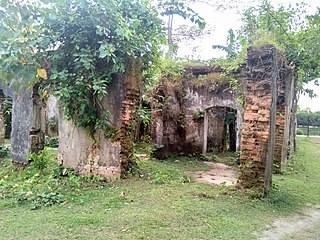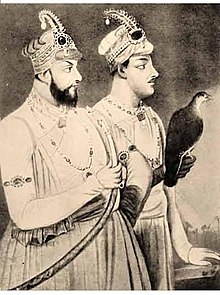
A jagir, also spelled as jageer, was a type of feudal land grant in the Indian subcontinent at the foundation of its Jagirdar (Zamindar) system. It developed during the Islamic rule era of the Indian subcontinent, starting in the early 13th century, wherein the powers to govern and collect tax from an estate was granted to an appointee of the state. The tenants were considered to be in the servitude of the jagirdar. There were two forms of jagir, one conditional, the other unconditional. The conditional jagir required the governing family to maintain troops and provide their service to the state when asked. The land grant, called iqta'a, was usually for a holder's lifetime; the land reverted to the state upon the death of the jagirdar.

A zamindar in the Indian subcontinent was an autonomous or semi-autonomous feudal ruler of a zamindari. The term itself came into use during the reign of Mughals, Marathas and later the British had begun using it as a native synonym for "estate". The term means landowner in Persian. They were typically hereditary, and held the right to collect tax on behalf of imperial courts or for military purposes.

The Permanent Settlement, also known as the Permanent Settlement of Bengal, was an agreement between the East India Company and landlords of Bengal to fix revenues to be raised from land that had far-reaching consequences for both agricultural methods and productivity in the entire British Empire and the political realities of the Indian countryside. It was concluded in 1793 by the Company administration headed by Charles, Earl Cornwallis. It formed one part of a larger body of legislation, known as the Cornwallis Code. The Cornwallis Code of 1793 divided the East India Company's service personnel into three branches: revenue, judicial, and commercial. Revenues were collected by zamindars, native Indians who were treated as landowners. This division created an Indian landed class that supported British authority.
Raja Ram was the first Jat leader, who organised a rebellion against Aurangzeb. He was the chieftain of Sinsini. Before Rajaram the Jats were organised by different village heads dotted around Agra, Mathura and the Yamuna river. To avenge the death of Gokula, Rajaram destroyed Akbar's tomb and dragged Akbar's bones and burned them with the help of the Jat Zamindars of Braj. After his death, his brother Churaman and son Fateh Singh continued the struggle against Aurangzeb.
Muqaddam is an Arabic title, adopted in other Islamic or Islamicate cultures, for various civil or religious officials.

Kaliganj is an upazila of the Lalmonirhat District in Rangpur Division, Bangladesh.
Sabarna Roy Choudhury was a Zamindar family of Mughal Bengal. They controlled significant swathes of territory, including what would later become Kolkata, prior to the sale of zamindari rights in 1698 to the East India Company.

Shuja-ud-Din Muhammad Khan was the Nawab of Bengal. He married Zainab un-nisa Begum and Azmat un-nisa Begum, the daughters of Murshid Quli Khan by Nasiri Banu Begum. Shuja-ud-Din's third wife was Durdana Begum Sahiba. After the death of his father-in-law on 30 June 1727, he ascended to the Masnad (throne) of the Nawab.

Raja Sitaram Ray (1658–1714) was an autonomous king, a zamindar to the Mughal Empire, who revolted and declared independence against the empire and established a short-lived sovereign Hindu dominion in Bengal region of the Indian subcontinent.

The Zamindars of Bengal were zamindars of the Bengal region of the Indian subcontinent. They governed an ancient system of land ownership.
Mukarram Khān Chishtī was the Subahdar of Bengal during the reign of Mughal emperor Jahangir from 1626 to 1627. Prior to this, he had served as the Thanadar of Bhawal, governor of Koch Hajo, Sardar of Sylhet and Subahdar of Orissa.

Zamindars of Natore were influential aristocratic Bengali Zamindars, who owned large estates in what is today Natore District in Bangladesh .
The siege of Jalalabad occurred in 1710 between the Mughal forces of Jalal Khan and the Sikh forces of Banda Singh Bahadur. Banda Singh Bahadur attacked the Mughal stronghold of Jalalabad. The army opposing Banda Singh was composed of a sizeable number of the Muslim zamindars and shurafa, including many Sadat, Banda Singh Bahadur repelled Mughal and Pathan forces after four days from the battlefield and back into the city, but failed to capture the city and withdrew.
The Kingdom of Laur was one of the many petty kingdoms of the Sylhet region. Others included the Gour Kingdom, Ita Kingdom, Taraf Kingdom, Pratapgarh Kingdom and Jaintia Kingdom.

The Greater Sylhet region predominantly included the Sylhet Division in Bangladesh, and Karimganj district in Assam, India. The history of the Sylhet region begins with the existence of expanded commercial centres in the area that is now Sylhet City. Historically known as Srihatta and Shilhatta, it was ruled by the Buddhist and Hindu kingdoms of Harikela and Kamarupa before passing to the control of the Sena and Deva dynasties in the early medieval period. After the fall of these two Hindu principalities, the region became home to many more independent petty kingdoms such as Jaintia, Gour, Laur, and later Taraf, Pratapgarh, Jagannathpur, Chandrapur and Ita. After the Conquest of Sylhet in the 14th century, the region was absorbed into Shamsuddin Firoz Shah's independent principality based in Lakhnauti, Western Bengal. It was then successively ruled by the Muslim sultanates of Delhi and the Bengal Sultanate before collapsing into Muslim petty kingdoms, mostly ruled by Afghan chieftains, after the fall of the Karrani dynasty in 1576. Described as Bengal's Wild East, the Mughals struggled in defeating the chieftains of Sylhet. After the defeat of Khwaja Usman, their most formidable opponent, the area finally came under Mughal rule in 1612. Sylhet emerged as the Mughals' most significant imperial outpost in the east and its importance remained as such throughout the seventeenth century. After the Mughals, the British Empire ruled the region for over 180 years until the independence of Pakistan and India. There was a complete list of the different amils who governed Sylhet which was recorded in the office of the Qanungoh of Sylhet. However, most complete copies have been lost or destroyed. Dates from letters and seal traces show evidence that the amils were constantly changed. In 1947, when a referendum was held, Sylhet decided to join the Pakistani province of East Bengal. However, when the Radcliffe Line was drawn up, Karimganj district of Barak Valley was given to India by the commission after being pleaded by Abdul Matlib Mazumdar's delegation. Throughout the History of Sylhet, raids and invasions were also common from neighbouring kingdoms as well as tribes such as the Khasis and Kukis.
Dahsala is an Indian system of land taxation which was introduced in A.D. 1580 under the reign of Akbar. This system was introduced by the finance minister of Akbar, Raja Todar Mal, who was appointed in A.D. 1573 in Gujarat, and it helped to make the system of tax collection from non-muslims more organised.

Farhād Khān, also known as Nizam-e-Zamanah or Nizam-e-Zaman, was a Mughal military strategist who had many positions throughout his life. He was the most well-known Faujdar of Sylhet Sarkar, governing in the late 17th century during the reign of Mughal emperor Aurangzeb. He was renowned for the construction of numerous bridges and places of worship in the region.

Mirak Bahadur Jalair was a Mughal officer during the reign of Emperor Jahangir. He served as the chief sardar of Sylhet Sarkar from 1617 to 1620.

The Subah of Lahore was a province of the Mughal Empire encompassing the central Punjab region, now divided between Pakistan and India. It was created as one of the original 12 Subahs of the Mughal Empire under the administrative reforms carried by emperor Akbar in 1580. The province ceased to exist after the death of its last viceroy, Adina Beg in 1758, with large parts being incorporated into Durrani Empire.
Hyderabad Subah, also known as Golconda Subah, was a province of the Mughal Empire encompassing the eastern Deccan region of the Indian subcontinent. It was created in 1687, during the reign of Mughal emperor Aurangzeb, by the annexation of the Golconda Sultanate. It later began to secede in the 18th century as the Mughal Empire declined and became fully independent as part of the Nizam-administered Deccan.










